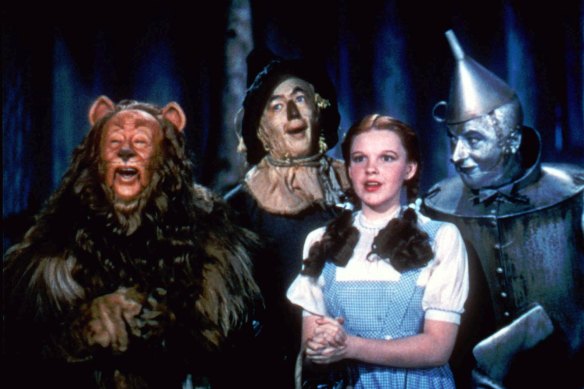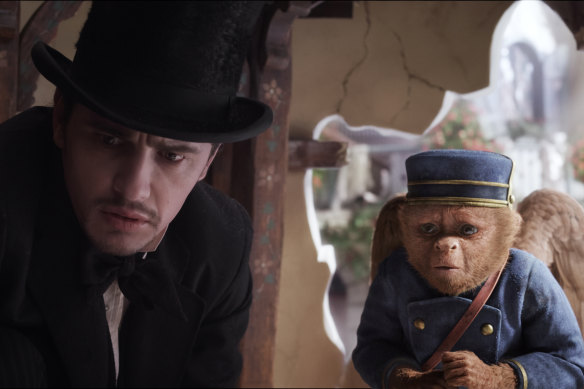Ding dong, the witch is dead. Or is she? The Wizard of Oz is back, with Warner Bros this week announcing a new, big-screen version – though it could be argued it never really went away.
Since the 1900 release of L. Frank Baum’s original book The Wonderful Wizard of Oz and its subsequent sequels, the world of Oz has been picked apart and repackaged time and time again. There’s the famous 1939 film starring Judy Garland, which arguably eclipsed the original books, but there’s also the 1978 reimagining The Wiz starring Diana Ross and Michael Jackson, the blockbuster musical Wicked, based on the 1995 book of the same name by Gregory Maguire, Return to Oz (1985), an unofficial sequel to the 1939 film, and Oz the Great and Powerful (2013) – a prequel I saw in the cinema and remember not one second of.
Later this month there will be a Melbourne staging of Il Mago di Oz, a new Italian opera inspired by the books. And this list barely scratches the surface – the books inspired so many to create their own versions that “Adaptations of The Wizard of Oz” has its own Wikipedia page.
With Bert Lahr as the Cowardly Lion, Ray Bolger as the Scarecrow, Judy Garland as Dorothy, and Jack Haley as the Tin Woodman, the stars of “The Wizard of Oz” sing together in this scene from the 1939 MGM classic film.Credit:AP
The list is now about to get even longer, with Kenya Barris, creator of the sitcom black-ish, announced as the writer and director of a reimagining of the original book, backed by Warner Bros. This instalment is not to be confused with another one also in the works by New Line Cinema.
Every time a remake of a classic film is announced I am suspicious and, I confess, a little grumpy. “There’s already a good one,” I mutter to anyone who’ll listen. “Why risk messing that up.”
Then, I try to fight this instinct by reminding myself there are a lot of good remakes. For every Psycho (1998) there’s a The Mummy (1999) to make up for it (yes, believe it or not, the Brendan Fraser version is a remake of a 1932 film with the same name). Then I remember, for every The Mummy (1999) there’s a The Mummy (2017) to drag us back down again.
For the most part, I’m tired of the “r”s: Remake, reimagining, resurrection, reunion. It seems that every film or TV show that reaches a certain level of success is at risk of someone coming along and poking through its bones to see what can be made from it (money).
James Franco as Oz in Oz the Great and Powerful (2013). Credit:AP Photo/Disney Enterprises
There are so many stories out there that have never been adapted, that could be brought to the screen – so if someone decides to go back over old ground, there needs to be a good reason why. If it’s simply to cash in on the goodwill and fame associated with a work, then it’s most likely going to be a wasted – and likely disappointing – experience for everyone involved on either side of the screen.
Sometimes, however, a filmmaker can harness the goodwill, the assumptions, that come with a work and use it to tell a new message, or breathe fresh life into something stale. Sometimes it enhances what came before. Other times, though, a stinker of a remake or an ill-thought-out years-later new season of a show can undercut a previously strong legacy. The best case scenario for these kind of works is that they sink without a trace – for example, did you know that there is a 2016 remake of Ben-Hur? Me neither, but apparently it cost $100 million to make.
With The Wizard of Oz, however, I’m cautiously optimistic.
The reason it is so enduring – and keeps being reworked and re-imagined – is because under the eccentric veneer it has evergreen, and often grim, themes. It explores the idea that there is no such thing as a utopia, suggesting even the most candy-coloured and seemingly pleasant fantasies have a dark underbelly. In The Wizard of Oz there is no running away from your problems – you just have to deal with them, while also looking for the good that is already around you. There are plenty of new stories to be mined with this at their core.
Anyway, even if the new versions do make a mess of things, this story’s already been so remade and reimagined over the years, you could probably make a nine-part gritty TV series told from the perspective of Toto the dog and not make a dent in the legacy of the book or the 1939 film.
A cultural guide to going out and loving your city. Sign up to our Culture Fix newsletter here.
Most Viewed in Culture
From our partners
Source: Read Full Article


